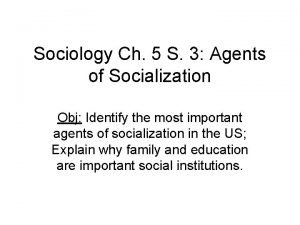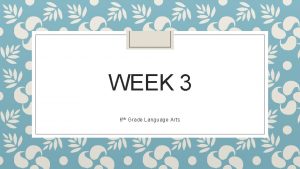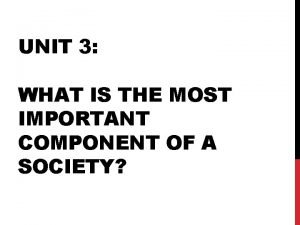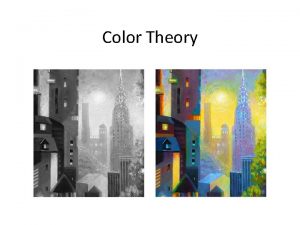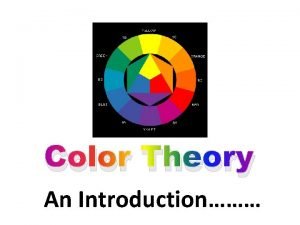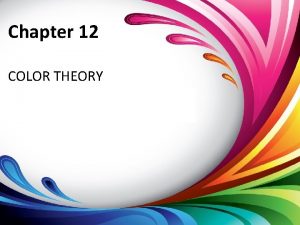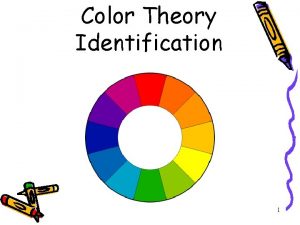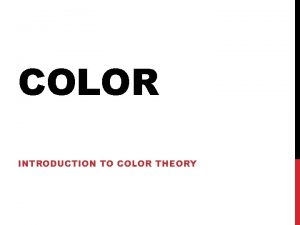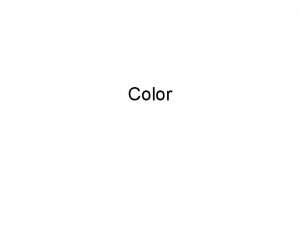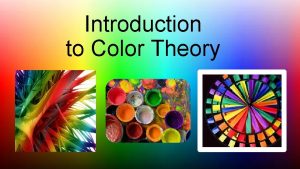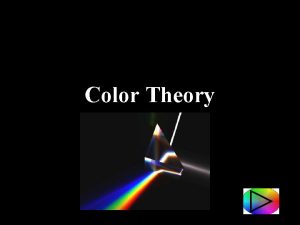Color Theory An Introduction Color The most important



















- Slides: 19

Color Theory An Introduction………

Color • The most important element in design • One of the first decisions made when decorating a room • Sets the mood in a room • Leaves a lasting impression with most people

: Primary Colors • The source of all colors • Cannot be made from mixing any other colors together • Red • Blue • Yellow

Secondary Colors • An equal blend of two primary colors • Green: a blend of blue and yellow • Orange: a blend of red and yellow • Violet: a blend of blue and red

Tertiary (Intermediate) • An equal blend of secondary and primary colors • Red-Orange • Yellow-Green • Blue-Purple • Red-Purple

Neutral • Contain equal parts of the primary colors • White • Grey • Black

Complementary • Two colors that are across from each other on the color wheel

Split Complementary • A color and the two colors that are next to the complementary color

Create your color wheel • On the color wheel provided, create your color wheel

Values • The amount of white or black in a color • Many more colors are created by adding white or black to a color on the color wheel – White + color = Tint – Color + black = Shade

Color Schemes • A systematic way of using the color wheel to put colors together Color Schemes are a systematic way of using the color wheel to put colors together

Types of Color Schemes • Monochromatic • Related -Analogous • Contrast -Complementary -Split Complementary -Triadic

Monochromatic • One color and its values

Analogous • Three to five colors adjacent to each other on the color wheel. This combination of colors provides very little contrast.

Contrast: Complementary Uses two colors that are across from each other on the color wheel

Contrast: Split Complementary Uses a color and the two colors that are next to the complementary color

Contrast: Triadic • Uses three colors equally spaced on the color wheel

Neutral + Accent • Uses white, gray, or black neutral tones with one color from the color wheel

Victorian Room Color Scheme • Choose one of the Victorian room sketches • Color it using one of the color schemes described • Identify the color scheme used.
 From most important to least important in writing
From most important to least important in writing Inverted pyramid in news writing
Inverted pyramid in news writing Least important to most important
Least important to most important Doctrine and covenants 130
Doctrine and covenants 130 Conclusion of salamanca statement
Conclusion of salamanca statement Most important agent of socialization
Most important agent of socialization Resocialization
Resocialization Different parts of body
Different parts of body Longitude are horizontal imaginary lines
Longitude are horizontal imaginary lines 2 most important commandments
2 most important commandments The most useful thing i have ever learned essay
The most useful thing i have ever learned essay What are two basic requirements for a healthy scalp
What are two basic requirements for a healthy scalp What were mansa musa's most important achievements
What were mansa musa's most important achievements The most important night of melanie's life
The most important night of melanie's life Water is one of the most important resources
Water is one of the most important resources The most important component
The most important component Most important organelle
Most important organelle Capillary exchange
Capillary exchange Universal existential statement examples in math
Universal existential statement examples in math Elements of plot
Elements of plot





